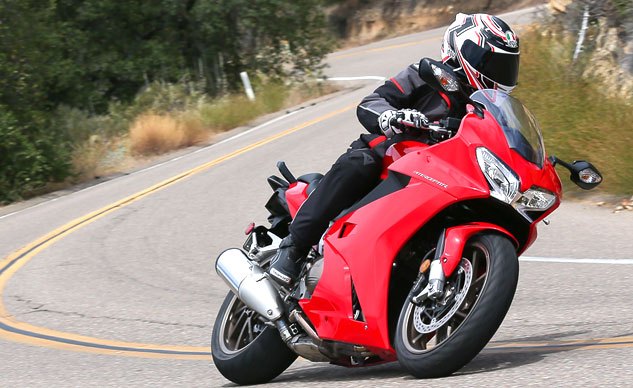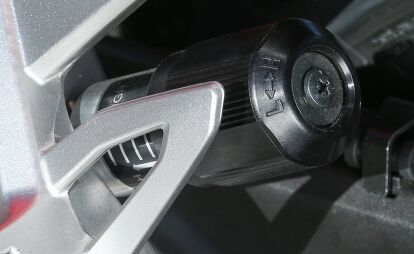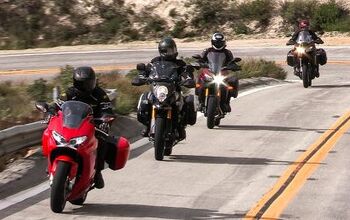2014 Honda Interceptor Review - First Ride

Honda's popular 800cc V-Four is back and better than ever.
Some motorcycles arrive on the scene with shock and awe pyrotechnics, delivering white-hot performance that was previously thought to be impossible from a streetbike. When you step off one of those machines, you feel as if the gravitational constant has shifted, like you’ll never look at a motorcycle the same way again.
2014 Honda Interceptor
| Engine | 17.5/20 |
| Suspension/Handling | 12.5/15 |
| Transmission/Clutch | 9.0/10 |
| Brakes | 9.25/10 |
| Instruments/Controls | 3.75/5 |
| Ergonomics/Comfort | 8.75/10 |
| Appearance/Quality | 9.0/10 |
| Desirability | 8.75/10 |
| Value | 8.0/10 |
| Overall Score | 86.5/100 |
The 2014 Honda Interceptor is not one of those machines. It was never intended to be. No single aspect of its performance was intended to break new motorcycling ground. Rather, the Interceptor delivers a stealth impression, a feeling that grows – in the background – over time until suddenly you realize (minus all the fireworks and laser beams) that Honda’s latest incarnation of the 800cc V-Four is a supremely capable motorcycle, one worthy of carrying on the heritage of the much beloved VFR line.
Family Heritage
At first glance, the 2014 Interceptor immediately looks familiar – only a bit different. The redesigned bodywork carries the same lines but in a new, sleeker form. Most noticeably, the side radiators have been replaced by front-facing ones, leaving swoopy plastic where it formerly had gills. The underseat exhaust has been replaced with a side-mounted muffler for weight savings and a lower CG. Even with an exhaust hanging off the side of the bike, the visual impression is that of a narrower, more aerodynamic motorcycle.
2008 Middleweight S-T Shootout: BMW F800ST Vs. Honda VFR800 Interceptor
The numbers bear out this hunch. The fairing is 1.5 inches narrower. This is emphasized by the seat shape which makes the Interceptor’s waist feel even more slight than its predecessor. Even without adjusting the seat from the 31.8 in. standard position to 31.0 in., the ground feels closer. Shorter riders only need to remove two “sockets” and lower two plates to drop the seat to the low position to give themselves a little less reach.
While redesigning the Interceptor’s slippery profile, Honda’s engineers took the opportunity to work on its bone structure and shave a few pounds from the previous model (which had started to feel a little portly). One area benefitting from this effort is the new, die-cast aluminum subframe that, since it no longer had the complication of an underseat exhaust, was able to lose 4.4 lb. over its steel predecessor. This change, because of its height and distance from the bike’s CG, goes a long way towards centralizing the mass and helping to lower the CG for sportier handling – paying dividends in turn-in quickness and lowering the effort required in side-to-side transitions.
The chassis retains its triple-box-section twin-spar perimeter-style, pivotless aluminum main frame. The engine keeps its stressed-member mounting, while the all-new swingarm still attaches to the engine casings for increased rigidity. Drawing on Honda’s VFR1200F, the swingarm plays a key role in the Pro-Arm rear suspension and its Pro-Link single shock. Although the stanchions maintained their 43mm diameter, the Showa fork’s internals have changed, and the sliders were reworked to accommodate radial mounts for the four-piston Tokico calipers.
First Ride of the 2002 Honda VFR Interceptor
Beefy 310mm front discs (up from 296 mm) are attached to new, lighter cast wheels. The hollow 10-spoke wheels are “fine-die cast,” which Honda claims is the “world’s first for this method of wheel construction.” To call more attention to the wheels, they received a bronze coating that is reminiscent of magnesium racing units. This color theme is carried through key places on the Interceptor (cam cover, engine side covers, triple clamp and handlebar risers), adding to the performance styling and tying the current generation Interceptor to the VFR’s racing roots.
Engine Compartment
The changes to the Interceptor’s V-Four engine could best be described as massaging and finessing its power delivery. In the press briefing, no mention was made of increased horsepower – something almost unheard of at press events. Instead, the emphasis was on low- to mid-range torque.
The Interceptor’s engine retains its basic 782cc DOHC oversquare 72.0mm x 48.0mm bore and stroke 90-degree V-Four cylinder layout. The high-pressure-formed cylinder sleeves are permeated with ceramic and graphite for reduced friction, wear and heat characteristics. Although the weight savings of the chain-drive cam system is important in a bike with sporting intent, we still miss the mechanical whine of the gear-driven valvetrain of the older VFRs.
The magic of the Interceptor’s engine takes place in the heads. Since 2002 – back when the bike was called the VFR800 Interceptor – the engine has used Honda’s VTEC to control valve behavior. Below 7,000 rpm, only two of the four valves per cylinder are activated, making the intake and exhaust gases flow with a higher velocity thanks to the total smaller opening provided by utilizing only a single intake and exhaust valve. Above 7,000 rpm, all four valves operate normally. This has the benefit of giving increased torque and fuel economy at lower rpm while still allowing for optimized power delivery (and, therefore, fun) in the upper rev-range. Oh, and it makes the engine sound super cool when it opens its mouth wider to inhale extra air and fuel.
For 2014, Honda focused on a complaint lodged against the previous generation. Namely, when the VTEC activated, it was very abrupt. If that happened mid-corner, it made it difficult to smoothly modulate the throttle and could upset the chassis. Honda says it directed its efforts towards improving low- to mid-range power and smoothing the hit provided by the VTEC. To restructure the power delivery, the engineers created new cam profiles, ported the heads and lengthened the funnels on the intake tract. Naturally, the PGM-FI fuel injection was optimized for these changes.
Additionally, dense, cool air on the left side of the radiator is redirected by special guides towards the airbox intake to improve power output. On the exit side of the engine, the new exhaust shaved 11 lb. compared to the previous high-mounted dual mufflers. Losing weight can be just as good as increasing horsepower – if not better because there’s less to slow down.
So, back to the VTEC’s power transition. When ridden aggressively, the power increase from all the valves coming online is noticeable – both from a power-delivery perspective and from the intake growl that flows to the rider from the space between the instrument cluster and the tank. The sound is intoxicating! The VTEC transition is almost seamless at speed.
Keep it old school with our test of the 1998 Honda VFR800FI Interceptor
However, in slow-moving traffic situations, the VTEC can display an odd behavior. If you’re moving along in first gear at a constant, partial throttle and let the rpm climb to the 7,000 rpm transition point, the engine will occasionally stumble rather abruptly when the additional valves are activated. I was never able to reproduce this consistently, but it did happen often enough to note.
Deluxe – What’s in a Label?
For 2014, the Interceptor has been divided into two models: the $12,499 base model and the $13,499 Deluxe. That extra $1,000 gets the Interceptor owner quite a lot.
The two key benefits to the Deluxe are Traction Control and ABS. Both of these technologies are mature enough to be expected on premium motorcycles. Don’t let the luddites fool you. Street bikes benefit from these technologies, and the inclusion of them on more bikes is a good thing. That said, the TC can be turned off with the push of a button on the left grip, letting those who are so inclined wheelie with abandon.
The importance of ABS was demonstrated on the press ride when one journalist entered a blind corner hard on the brakes only to discover dirt on the pavement. While the ABS prevented him from locking up the front, he was given the time to choose between standing the bike up and stopping it in the runout area or attempting to ride out the turn. Without ABS, he, most likely, would not have had the time to make that choice.
The Interceptor Deluxe receives suspension upgrades in the form of a rebound- and preload-adjustable fork and a conveniently located preload adjuster for the shock (in addition to the standard locking-collar preload and rebound adjusters).
Convenience features, like a centerstand, are also part of the Deluxe package. Add to that heated grips with five levels of adjustment via the left thumb. Using technology introduced earlier this year on the 2014 Valkyrie, self-canceling turn signals come as part of the ABS package since they both rely on wheel sensors. While no signal canceling technology is perfect, this new system goes a long way towards making it more usable in the real world.
Some convenient technology also makes its way into both the standard and Deluxe models. The handy gear indicator is a mechanical unit rather than a software one that guesses from rpm and speed. This means that there is no delay while it calculates the gear after a shift and, when the clutch is disengaged, the readout doesn’t go away. A nice little touch.
The instrument cluster is well laid out and appointed. The big, centrally located dial tachometer is easy to read. Idiot lights line the top of the dash, flanking the tach. The LCD screen to the left of the rev counter features a bar-graph fuel gauge and the speedometer. The right LCD screen is where the action happens on long rides. On the top is the odometer, dual tripmeters, and countdown. The countdown is not miles until empty which would be quite useful. Instead, it counts down from a number that the rider manually sets from 0–999.9 mi.
The middle row of numbers on the LCD give: current fuel mileage, average fuel mileage, average speed, coolant temperature, and ambient temperature. Interestingly, the average readings are linked to the two tripmeters, meaning that two sets of averages, say those for the current tank and those for a multi-day tour, can be maintained. A clock is displayed in the lowest row on the right LCD.
While having this information at your fingertips is cool, actually accessing it is made quite difficult by the awkward location of the control buttons on the lower left side of the dash behind the clutch master cylinder. This is very un-Honda-like and makes it difficult to perform mundane tasks like switching from ambient to coolant temperature while riding.
Throw a Leg over It
The Interceptor’s riding position is comfortably sporty. For my 32 in. inseam, the peg location is high enough to keep the feelers off the ground in most situations but not so high as to cramp muscles on longer rides. The slightly rearward location of the pegs lets me naturally lean forward to reach the controls. However, if that lean is too far for your tastes, Honda has accessory handlebar risers that move the grips 14mm higher and 7mm rearward. At speed, the wind blast hits my 5’ 11” body at about shoulder level, leaving my helmet in the clean, turbulence-free, and, hence, quieter air. Again, Honda has a taller accessory windscreen that will offer more wind protection.
The engine pulls cleanly off the line and offers crisp throttle response throughout the rev range. The bottom end is tractable without being overly strong. Around town there’s still enough top-end whine to remind the rider that a V-Four resides between the knees. Once into the mid-range, the engine begins to perk up.
Pull the Interceptor’s tail, and things get interesting. While the mid-range is strong, there is a noticeable increase in power after crossing the 7,000 rpm line. The sound emanating from the intake deepens to a snarl, as VTEC brings the additional valves into play, and it builds all the way to redline. However, the Interceptor is not a bike tuned for peak power in the manner of a supersport-focused machine. The emphasis is on real-world power that can be utilized on the street. In this regard, the V-Four excels, having more than enough oomph to charge to the next corner.
The EFI works flawlessly in almost all situations, handling transitions off- and on-throttle in the myriad of ways they can happen when riding through a winding section of unfamiliar tarmac. Similarly, neutral throttle was easy to maintain. The only time on-throttle transitions were abrupt occurred when the revs were allowed to drop too much in a higher gear. In this case, the engine was so far out of its powerband that a couple downshifts were prudent, anyway. It should be noted, however, that for a bike tuned for low- to mid-range power, the engine clearly preferred to be kept in the mid-range and up. Outside of the urban shuffle, the bottom end wasn’t much to speak of.
One area where the engine seemed extremely happy was shifting. The short shifter throw was easy to make in anger with the engine seeming to relish clutchless upshifts. When barreling into a corner, hard on the brakes while banging downshifts, a slipper clutch would’ve been appreciated in those times when the rear wheel started skipping.
Speaking of hard braking, the Interceptor’s brakes are powerful and, thankfully, aren’t linked. Now, those of us who use the rear brake in a corner to modulate speed can do so without fear of causing the chassis to shift its weight forward. The binders themselves offer an easy initial bite before settling in to delivering the amount of power the rider requests. The braking effort falls into Goldilocks territory, being neither too soft nor too firm but just right.
The same could be said of the Interceptor’s steering response. While not lightning-fast, it is responsive enough to easily work its way down the road from peg feeler to peg feeler. California mountain roads always serve up their share of debris to be avoided, and changing lines mid-corner could be handled quickly and precisely. Though it is unlikely that many Interceptors will make it to track days, the handling wouldn’t be out of place in a closed course environment.
Around town and on the highway, the ride is sporty but not harsh. This bike would be happy loaded up with the optional hard bags and pointed anywhere on any kind of road. At sport-riding speeds on backroads, suspension remains firm and transmits smaller road irregularities to the rider’s hands, but bigger bumps are absorbed quite well until they reach a size large enough to upset the chassis. In these cases, the suspension oscillates for a couple cycles before settling down. When the road gets seriously bumpy, the suspension becomes overwhelmed, rebounding noticeably.
Adding a little rebound damping stabilized the bike on average bumps, but I never encountered another seriously bumpy road to see if it helped keep the suspenders from getting so unhappy.
Reunion Tour
Since so many previous VFR800 owners used them as sport-tourers with hard bags, all of the journalists at the Interceptor’s introductory ride were disappointed to learn that no bags were currently stateside. We were all anxious to test the sexy new mounting hardware and see how the bike performed with the bags in place. That will have to wait for another time, but the Interceptor’s highway manners were impeccable. The engine loafs along at 5,000 rpm at 70 mph in top gear. Vibration doesn’t make an appearance in the pegs until about 6,500 and then moves to the grips above 7,000. With the average mileage reading around 42 mpg for the day’s ride, the Interceptor’s range with its 5.6-gal. tank full should be comfortably above 200 mi.
Honda has brought back the Interceptor in fine form. The bike’s primary issues of excessive weight and an abrupt transition to VTEC have been addressed, leaving the rider with a overriding impression of supreme competence. This type of motorcycle requires the manufacturer to trust the buyer to understand that there is more to the machine than the flash of an initial impression, but rather, like any relationship, the understanding of the Interceptor’s capabilities will grow in appreciation over time.
The 2014 Honda Interceptor is arriving in showrooms this month and is available in red and pearl white.
+ Highs
- Improved power delivery
- No linked brakes!
- Weight loss
– Sighs
- Bumpy roads can overwhelm suspension
- No slipper clutch
- Awkward dash controls

Like most of the best happenings in his life, Evans stumbled into his motojournalism career. While on his way to a planned life in academia, he applied for a job at a motorcycle magazine, thinking he’d get the opportunity to write some freelance articles. Instead, he was offered a full-time job in which he discovered he could actually get paid to ride other people’s motorcycles – and he’s never looked back. Over the 25 years he’s been in the motorcycle industry, Evans has written two books, 101 Sportbike Performance Projects and How to Modify Your Metric Cruiser, and has ridden just about every production motorcycle manufactured. Evans has a deep love of motorcycles and believes they are a force for good in the world.
More by Evans Brasfield


































































Comments
Join the conversation
Thanks to the crap VTEC idiocy on this bike you'll have fun with the terrible hassle, downtime, and expense that valve adjustment time will bring you!
I am not sure about the price on this bike. What makes it so much better than the Ninja 1000, which is 200cc's bigger, with the same stuff (ABS, Traction Control, Different Modes) and $2000.00 cheaper...can someone shed some light, as this bikes price tag seems to me a little much